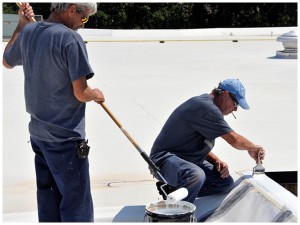Metal roofs are a lot less work than other kinds of roofs when it comes to maintenance, and can provide your home with protection for generations if taken care of properly. All metal roofs will come with a protective coating; however, this coating may not last very long. Therefore, the first and best step you will ever make in protective maintenance of your metal roof is to cover it with a new, reliable protective coating. Several different choices of metal EPDM coating are available and they include polymeric and asphalt coatings.
Most metal roofs are constructed using long metal sheets or with metal tiles. It doesn’t matter what kind of material is used on your roof, there is going to be a danger that, at every intersection where the tiles or sheets are overlapped, leaks can occur. Metal roofs will usually wear fastest around the ridge and valley of the roof, as well as around the fascia board. This can be avoided with proper maintenance.
What’s Necessary ?
The majority of metal roofs are protected by being either aluminized or galvanized, or else they are painted with galvalume protective coating. Each of these materials is pretty much maintenance free, although regular cleaning is a necessity. However, it is better to add your own, high-performance protective coating if you want true piece of mind.
Out of all the different protective metal roof paints available, perhaps one of the best ones is Polyyinylidene Fluoride or PVDF. PVDF can increase the strength of the metal on your roof, it is resistant to chemicals and corrosive substances, it offers the highest weather resistance, protection from UV rays and it is even resistant to fungi. When you apply a PVDF treatment to your metal roof, you should only need to check it every 9 or 10 years to see if a new coat is required, while other metal roof finishes such as plastisol, acrylic and urethane will need checking after just 3 to 5 years.
Metal Roof Sealants
There are many great and innovative new solutions for metal roof sealing. Traditionally used ashphaultic sealants have been outperformed when compared to newer products such as the micro sealant called Eternal Bond. This new product comes as a large roll of sticky tape and can be applied easily by anyone, even somebody with no experience. The Eternal Bond tape offers great resistance to temperature extremes and inclement weather, and it’s a good fix for leakages too. However, it’s worthwhile to know that while a sealant such as this is great for patch up jobs, employing preventative measures such as a EPDM roof coatings means that it’s unlikely you will ever need to use a sealant.
Things to Know :
Before undertaking any maintenance we recommend that you consult a roofing expert about all the safety precautions you should take before climbing onto the roof.
The following steps should be followed carefully when it comes to carrying out metal roof maintenance work:
- Do not allow different kinds of metal to be touching one another. When different metals touch, chemical reactions can occur and cause the metal to corrode.
- Be vigilant and make sure the paintwork is always touched up. This will help to prevent rust.
- As soon as you spot a hole or an open seam, repair it immediately, do not delay!
- Smaller holes can be covered with either roofing cement, or else the EternaBond tape that was discussed previously. Large holes need to be patched and soldered into place with the same kind of metal as the roof is made from.
- Any screws that you use must be of the same kind of metal as the roof.
- When screwing plates or sheets into place, make sure you always use a washer, and install the screw into a raised area rather than low areas as this can lead to water pooling and eventual leaks.
- Use only non-corrosive metal flux with steel roofs. For copper roofs, acid flux is best.
These are the tools necessary for carrying out metal roofing repairs:
- Galvanized metal
- Screws of the same type of metal as the roof
- Roof coating such as PVDF
- A putty knife
- Butyl tape or Eternal Bond tape
- Roofers caulk
- Wire brush
- Snips
Steps to take when patching a hole:
- Firstly, clean the area around the hole thoroughly, washing away all dust.
- Cut a good sized piece of galvanized metal that covers the hole easily. You should have a bearing of 2 or 3 inches over the edge of the hole.
- Tape the galvanized metal sheet into place with the butyl tape.
- Screw the sheet into the roof, spacing the screws out every 2-3 inches.
- Seal the edges of the sheet and around the screws with caulk.
- Finally, cover the new patch with PVDF roof coating.



